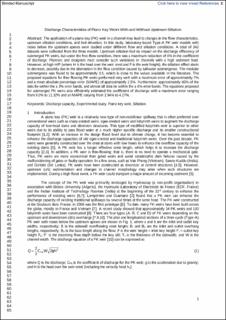| dc.contributor.author | Kumar, Binit | |
| dc.contributor.author | Kadia, Subhojit | |
| dc.contributor.author | Ahmad, Zulfequar | |
| dc.date.accessioned | 2022-02-04T11:42:54Z | |
| dc.date.available | 2022-02-04T11:42:54Z | |
| dc.date.created | 2021-02-04T21:25:31Z | |
| dc.date.issued | 2021 | |
| dc.identifier.citation | International Journal of Civil Engineering. 2021, 19 (9), 1043-1054. | en_US |
| dc.identifier.issn | 1735-0522 | |
| dc.identifier.uri | https://hdl.handle.net/11250/2977160 | |
| dc.description.abstract | The application of a piano key (PK) weir in a channel may lead to changes in the flow characteristics, upstream siltation conditions, and bed elevation. In this study, laboratory-based Type-A PK weir models with noses below the upstream apexes were studied under different flow and siltation conditions. A total of 342 datasets were collected from the three models. Upstream siltation had no impact on the discharge efficiency of submerged PK weirs, but under the free-flow condition, there was a maximum reduction of 4% in the coefficient of discharge. Planners and designers must consider such variations in channels with a high sediment load. However, at high H/P (where H is the head over the weir crest and P is the weir height), the siltation effect starts to decrease, possibly due to the alternation in the flow condition caused by tailwater submergence. The modular submergence was found to be approximately 0.5, which is close to the values available in the literature. The proposed equations for free-flowing PK weirs performed very well with a maximum error of approximately 7% and a mean absolute percentage error (MAPE) of approximately 2.5%. Furthermore, approximately 60% of the data lie within the ± 3% error bands, and almost all data lie within the ± 6% error bands. The equations proposed for submerged PK weirs also efficiently estimated the coefficient of discharge with a maximum error ranging from 9.0 to 11.32% and an MAPE varying from 2.94 to 4.27%. | en_US |
| dc.language.iso | eng | en_US |
| dc.publisher | Springer | en_US |
| dc.title | Discharge Characteristics of Piano Key Weirs With and Without Upstream Siltation | en_US |
| dc.type | Peer reviewed | en_US |
| dc.type | Journal article | en_US |
| dc.description.version | acceptedVersion | en_US |
| dc.rights.holder | This is the authors' accepted manuscript to an article published by Springer. Locked until DATO due to copyright restrictions. | en_US |
| dc.source.pagenumber | 1043-1054 | en_US |
| dc.source.volume | 19 | en_US |
| dc.source.journal | International Journal of Civil Engineering | en_US |
| dc.source.issue | 9 | en_US |
| dc.identifier.doi | 10.1007/s40999-021-00607-x | |
| dc.identifier.cristin | 1886945 | |
| dc.description.localcode | This is the authors' accepted manuscript to an article published by Springer. Locked until 15/3-2022 due to copyright restrictions. | en_US |
| cristin.ispublished | true | |
| cristin.fulltext | postprint | |
| cristin.qualitycode | 1 | |
